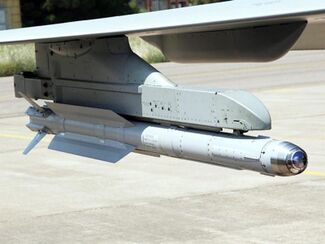M-9 IRSS: Difference between revisions
No edit summary |
No edit summary |
||
| Line 60: | Line 60: | ||
}} | }} | ||
The '''M-9 IRSS''' is an {{wp|Infrared homing|infrared homing}} {{wp|air-to-air missile}} designed and manufactured by Kobalt-Zeiss AG and NordEX Försvarssystemet AB in conjunction with the M-13 IRSS. The missile was designed to improve upon design cues adopted with the M-7 SIR missile that it was intended to replace, namely improving upon the M-7's off-boresight capability, ability to filter out countermeasures, and maneuverability. It was designed in tandem with the [[M-13 MSRA]] active-radar homing missile for use with the [[MDA EF | The '''M-9 IRSS''' is an {{wp|Infrared homing|infrared homing}} {{wp|air-to-air missile}} designed and manufactured by Kobalt-Zeiss AG and NordEX Försvarssystemet AB in conjunction with the M-13 IRSS. The missile was designed to improve upon design cues adopted with the M-7 SIR missile that it was intended to replace, namely improving upon the M-7's off-boresight capability, ability to filter out countermeasures, and maneuverability. It was designed in tandem with the [[M-13 MSRA]] active-radar homing missile for use with the [[MDA EF 650 Striga|EF-650 Striga]] and [[MDA EF 662 Vampyr|EF-662 Vampyr]] fighters, as well as to equip the [[Norderstedt EF 135 Draken|EF-135 Draken]] and [[MDA EF 161 Raven|EF 161 Raven]] with more capable armament. The missile improved upon its predecessor's range, and has a maximum effective range of 30 km. As a clean-sheet design, the missile was also shaped to provide a reduced radar cross-section and to better fit into the weapons bays of the EF-633 and EF-662. | ||
== Design == | == Design == | ||
Revision as of 22:48, 28 April 2021
| M-9 IRSS | |
|---|---|
 | |
| Type | Infrared tracking short-range air-to-air missile |
| Place of origin | |
| Service history | |
| In service | 2006-Present |
| Used by | Acrea |
| Wars | Zemplen War |
| Production history | |
| Designer | Kobalt-Zeiss AG NordEX Försvarssystemet AB |
| Manufacturer | NordEX Försvarssystemet AB |
| Specifications | |
| Weight | 87.4 kg (193 lb) |
| Length | 2.9 m (9 ft 6 in) |
| Diameter | 127 mm (5.0 in) |
| Effective firing range |
|
| Warhead | High explosive blast-fragmentation |
Detonation mechanism | Active radar proximity fuze or direct impact |
| Engine | Solid-propellant rocket motor |
| Speed | Mach 3 |
Guidance system | All-aspect infrared homing |
The M-9 IRSS is an infrared homing air-to-air missile designed and manufactured by Kobalt-Zeiss AG and NordEX Försvarssystemet AB in conjunction with the M-13 IRSS. The missile was designed to improve upon design cues adopted with the M-7 SIR missile that it was intended to replace, namely improving upon the M-7's off-boresight capability, ability to filter out countermeasures, and maneuverability. It was designed in tandem with the M-13 MSRA active-radar homing missile for use with the EF-650 Striga and EF-662 Vampyr fighters, as well as to equip the EF-135 Draken and EF 161 Raven with more capable armament. The missile improved upon its predecessor's range, and has a maximum effective range of 30 km. As a clean-sheet design, the missile was also shaped to provide a reduced radar cross-section and to better fit into the weapons bays of the EF-633 and EF-662.
Design
Propulsion
The IRSS uses a solid-propellant rocket motor for propulsion, developed and improved upon from its predecessor to increase its maximum capable speed from Mach 2.5 to Mach 3, and also giving it superior initial acceleration off the rail. The missile is fitted with thrust vectoring control to enable its kinematic performance to match the improved off-boresight performance of the seeker head.
Control
The IRSS carries a new seeker head with improved infrared counter-countermeasures and better high off-boresight performance, and can now lock onto targets up to 90° of the missile's centerline compared to its predecessor's 60°. With thrust vectoring, the missile is capable of withstanding forces as high as 60 g at a turn rate of 60° per second. It is noted that although the missile can intercept targets up to 30 km away, that its countermeasure discrimination capabilities are substantially better when within 25km of a target. It is capable of both lock-on-before-launch and lock-on-after-launch.